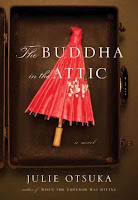In August, I participated in the Art of the Novella Reading Challenge. The idea was conceived by Frances over at nonsuchbook, with Melville House, the publisher, graciously getting on board. Frances decided to read all forty-two novellas during August, and blog about each one. Fortunately, she realized that not all of us were up to such a challenge, and invited readers to set their own goals.
Originally, I was planning on just reading one book. Then, after looking at the list, and trying to see what I could get from my library, I decided to go for the “Fascinated” level – three books. I’m happy to report that I met my (modest) goal.
I’m glad that I decided to read three novellas. I hated the first one I read – Leo Tolstoy’s The Devil. I posted a review, and emailed it, along with a notice of my participation, to Melville House. I was surprised to get a personalized email back, with some suggestions with books I may like better. How nice! The next book was George Eliot’s The Lifted Veil, which I enjoyed. The best ended up coming last, though, with Sarah Orne Jewett’s The Country of the Pointed Firs. I’m really glad that I stuck out that challenge and read some good books. Oh, and I also ended up winning one of Melville House’s daily giveaways – and they sent me SEVEN books. Seven! I am in seven book heaven.
Okay, so let’s break down my reading:
14 books total
10 fiction 71%
4 nonfiction 29%
8 female authors 57%
3 works in translation 21%
(I've also started two more, but they'll be counted in next month's totals).
My favorites this month were The Salt Roads and The Country of the Pointed Firs. They are completely different, but both excellent.
10 fiction 71%
4 nonfiction 29%
8 female authors 57%
3 works in translation 21%
(I've also started two more, but they'll be counted in next month's totals).
My favorites this month were The Salt Roads and The Country of the Pointed Firs. They are completely different, but both excellent.
I’ve already posted reviews for most of these, which you can find by either checking the archive to the right, or by going to the Books Read 2011 tab linked at the top of this page. The title will take you to the review, if I’ve posted it. For those that I haven’t reviewed yet – well, they’re coming, promise. Most are half-written jumbles of my thoughts, or they are mulling around in my head, as yet uncommitted to the page (er, screen). A couple are even finished and scheduled to post J
How was your month in reading? Anything you’d recommend – either to read, or to stay far away from?












































